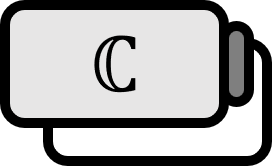Proof of Fresnel Integrals
Theorem 1
$$ \int_{0}^{\infty} \cos x^2 dx = \int_{0}^{\infty} \sin x^2 dx = {{1}\over{2}} \sqrt{{\pi}\over{2}} $$
Description
Fresnel integrals may appear simple at first glance, but the outcome is not as straightforward as it appears. It would be easier if it was merely the square of trigonometric functions, but it is due to the squaring of $x$ contained within them. Once you actually delve into it, you can appreciate how persistently $x$ refuses to vanish.
The core issue lies within the variable contained in the function, making it difficult to even begin to visualize the shape of the graph. Does an improper integral exist at all? Does it draw a wave? Does it have a periodicity that gradually decreases? The more you think about it, the harder it becomes to definitively say yes or no to any question.
However, using complex analysis, the problem can be relatively easily solved. The more one explores such solutions, the more one must acknowledge the indispensable role of complex numbers in solving real-number problems.
Proof

Consider a simple closed path $\mathscr{C}$ as a quarter-circle with radius $R$ as shown in the figure, and divide them into $L_{1} , L_{2} ,L_{3}$ as illustrated. $$ \begin{align*} L_{1} :& z(t) = R e^{i t} & , 0 \le t \le {{\pi} \over {4}} \\ L_{2} :& z(t) = \left( {{R} \over {\sqrt{2}}} - t \right) + i \left( {{R} \over {\sqrt{2}}} - t \right) & , 0 \le t \le {{R} \over {\sqrt{2}}} \\ L_{3} :& z(t) = t & , 0 \le t \le R \end{align*} $$ Then, by Cauchy’s theorem $$ \int_{\mathscr{C}} e^{-z^2} dz = \int_{L_{1}} e^{-z^2} dz + \int_{L_{2}} e^{-z^2} dz + \int_{L_{3}} e^{-z^2} dz =0 $$
Part 1. $L_1$ $$ \int_{L_{1}} e^{-z^2} dz = \int_{0}^{ {{\pi} \over {4}} } e^{-R^2 \text{cis} 2t } i R e^{it} dt = \int_{0}^{ {{\pi} \over {4}} } R \left( e^{ \text{cis} 2t } \right) ^{- R^2} i e^{i t} dt $$ The first integral will converge to $0$ when $R \to \infty$.
Part 2. $L_2$ $$ \sqrt{2} \left( {{R} \over {\sqrt{2}}} - t \right) = z $$ By substituting it becomes $-\sqrt{2} dt = dx$ therefore, $$ \begin{align*} & \int_{L_{2}} e^{-z^2} dz \\ =& \int_{0}^{{{R} \over {\sqrt{2}}}} e^{-2i \left( {{R} \over {\sqrt{2}}} - t \right)^2 } (-1-i) dt & \because dz \to dt \\ =& \int_{R}^{0} e^{- i x^2 } (-1-i) \left( -{{1}\over{\sqrt{2}}}\right) dx & \because dt \to dx \\ =& -{{1}\over{\sqrt{2}}} (1+i) \int_{0}^{R} e^{- i x^2 } dx \\ =& -{{1}\over{\sqrt{2}}} (1+i) \int_{0}^{R} \left( \cos \left( - x^2 \right) + i \sin \left( - x^2 \right) \right) dx \\ =& -{{1}\over{\sqrt{2}}} (1+i) \int_{0}^{R} \left( \cos x^2 - i \sin x^2 \right) dx \\ =& -{{1}\over{\sqrt{2}}} \int_{0}^{R} \left\{ \left( \cos x^2 + \sin x^2 \right) + i \left( \cos x^2 - \sin x^2 \right) \right\} dx \end{align*} $$
Part 3. $L_3$
$$ \int_{L_{3}} e^{-z^2} dz= \int_{0}^{R} e^{-t^2} dt $$
By Gaussian integration, when $R \to \infty$, it will converge to $\displaystyle {{\sqrt{\pi}}\over{2}}$.
Part 4. $\mathscr{C}$
Since $\displaystyle \lim_{R \to \infty} \int_{\mathscr{C}} e^{-z^2} dz = 0$, $$ \lim_{R \to \infty} {{1}\over{\sqrt{2}}} \int_{0}^{R} ( \cos x^2 + \sin x^2 ) dt = {{\sqrt{\pi}}\over{2}} \\ \displaystyle \lim_{R \to \infty} {{1}\over{\sqrt{2}}} \int_{0}^{R} i ( \cos x^2 - \sin x^2) dt = 0 $$ The imaginary part must be $0$, therefore $$ \int_{0}^{\infty} \cos x^2 dx = \int_{0}^{\infty} \sin x^2 dx $$ Hence, the real part is $$ \sqrt{2} \int_{0}^{\infty} \cos x^2 dx = {{\sqrt{\pi}}\over{2}} $$ Upon rearranging properly, one gets $$ \int_{0}^{\infty} \cos x^2 dx = \int_{0}^{\infty} \sin x^2 dx = {{1}\over{2}} \sqrt{{\pi}\over{2}} $$
■
Osborne (1999). Complex variables and their applications: p93. ↩︎
